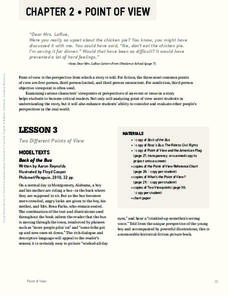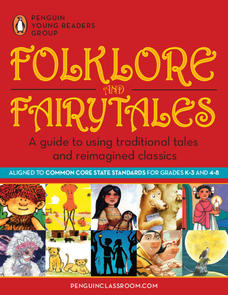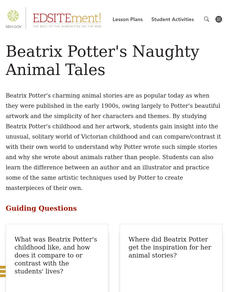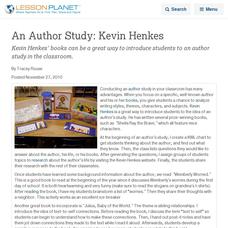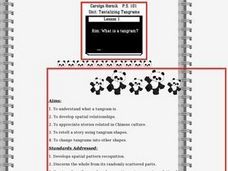Curriculum Corner
ELA Common Core Checklists for K-6
In the hustle and bustle of life in the classroom, it's easy for teachers to lose track of the standards they have taught, and those that still need to be addressed. This Common Core checklist provides educators with an easy-to-use...
Mary Pope Osborne, Classroom Adventures Program
Civil War on Sunday
Reading Mary Pope Osborne's Civil War on Sunday? Here's a packet crammed with activities, exercises, reading guides, and project suggestions. A must-have for your curriculum library.
Gwinnett County Public Schools
Analysis of the Tuck Everlasting and The Birchbark House Text Exemplars
Looking to introduce some text-based questions into your ELA lessons? Practice the kinds of skills the Common Core demands with the seven text-based questions and the essay prompt provided here. Designed to be a three-day lesson, day one...
Curated OER
The Magical World of Russian Fairy Tales
Students read several fairy tales of Russian origin. They brainstorm common elements of a fairy tale and identify those elements in several examples. They retell a favorite fairy tale through a skit, oral storytelling, a sketch, or a...
ReadWriteThink
Teaching Point of View With Two Bad Ants
What better way to explain the concept of point of view than from an ant's perspective! After reading Two Bad Ants, pupils identify the point of view of the ants by studying the text and pictures. Then, they fill out a chart that...
Scholastic
Point of View
The point of view in a story can dramatically change the story itself. Focus on finding the points of view in various reading passages with a language arts packet, which includes fiction and nonfiction text.
Penguin Books
Folklore and Fairytales: A Guide to Using Traditional Tales and Reimagined Classics
Every culture has its own stories to tell. An interesting educator's guide shares a large collection of fairytales and folktales, some from different cultures and some re-creations of classics. A summary and brief teaching ideas...
Curated OER
Hans Christian Andersen's Fairy Tales
A thorough instructional activity introduces learners to Hans Christian Andersen, the nineteenth-century author who created wonderful tales. They read the original texts of several of his stories, including "The Ugly Duckling," "The...
Curated OER
Beatrix Potter's Naughty Animal Tales
Students gain insight into the unusual, solitary world of Beatrix Potter's Victorian childhood and can compare/contrast it with their own world to explain why Potter wrote such simple stories and why she wrote about animals rather than...
Curated OER
No more Boring Book Reports
Learners create a paper bag book report. In this book report instructional activity, students choose 5-7 items representing the story. Learners fill and decorate their bags and present them to the class. Students describe the...
Curated OER
An Author Study: Kevin Henkes
Kevin Henkes' books can be a great way to introduce students to an author study in the classroom.
Curated OER
What is a Tangram?
Students identify a tangram. In this geometry lesson, students read Grandfather Tang's Story and retell each story using the tangrams on a flannel board. Students use tangrams to complete an included worksheet.
Curated OER
Retell the "Tail" of the Tale
Students explore story structure. In this multicultural literacy lesson plan, students discuss common elements of folk tales and then listen to the story Tiger and the Big Wind: A Tale from Africa. Students identify the problem and...
Curated OER
Stone Soup Lesson Plans
With "Stone Soup" lesson plans students can learn about cooperation, and have a delicious meal, all at the same time.
Curated OER
Comic and Film Strip Writing
Students write a funny story and illustrate it in a comic strip. For this comic strip lesson, students study comic strips and determine the plot of each story. Students then write a short story and illustrate it using a comic strip...
Curated OER
Tracking Down Meaning in Great Expectations
Fourth graders are assigned an unique theme, symbol, or character in Great Expectations. They becomes the class expert on that facet of the novel while learning the basic skills needed to write a research paper.
Curated OER
Coyote and Anansi
Students explore the structure of folktales. For this coyote and Anansi lesson, students discuss the attributes of folktales as they read versions of tales featuring coyote and Anansi. Students collaborate to write and perform their own...
Curated OER
Literature-based Skill Building: Holes by Louis Sachar
In this literature response worksheet, students answer 7 essay questions about Chapter 11 of the book called Holes by Louis Sachar.
Curated OER
Discovering the Oregon Trail
Students explore U.S. history by researching the Oregon Trail. In this American exploration instructional activity, students read the story On the Shore of the River and define the exact path early settlers took to find the state of...
Curated OER
Understanding Genres
Young scholars identify genres of literature. In this literature instructional activity, young scholars read definitions of the various genres. Young scholars choose books and list clues in the texts that help them identify the...
Curated OER
Literature Comprehension
In this reading comprehension worksheet, students use the SADDR method to understand the literary tools used in a book. Students complete a speech analysis, action analysis, description analysis, drawing activity, reactions of others...
Other popular searches
- Analyzing Characters Mystery
- Analyzing Characters Notes
- Analyzing Characters Buck
- Analyzing Characters Paper







